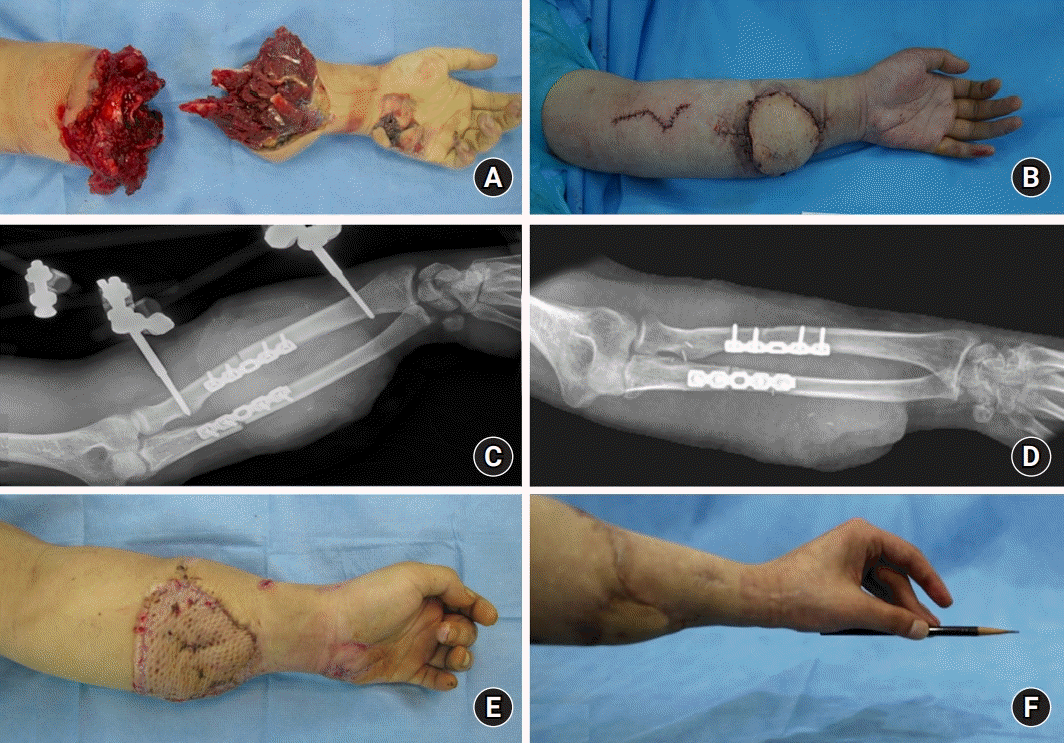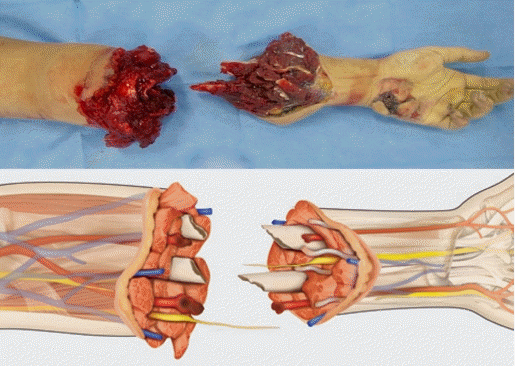1. Malt RA, Mckhann C. Replantation of severed arms. JAMA. 1964; 189:716–22.

2. Graham B, Adkins P, Tsai TM, Firrell J, Breidenbach WC. Major replantation versus revision amputation and prosthetic fitting in the upper extremity: a late functional outcomes study. J Hand Surg Am. 1998; 23:783–91.

3. Gold AH, Lee GW. Upper extremity replantation: current concepts and patient selection. J Trauma. 1981; 21:551–7.
4. Prucz RB, Friedrich JB. Upper extremity replantation: current concepts. Plast Reconstr Surg. 2014; 133:333–42.
5. Yaffe B, Hutt D, Yaniv Y, Engel J. Major upper extremity replantations. J Hand Microsurg. 2009; 1:63–7.

6. Otto IA, Kon M, Schuurman AH, van Minnen LP. Replantation versus prosthetic fitting in traumatic arm amputations: a systematic review. PLoS One. 2015; 10:e0137729.

7. Sabapathy SR, Venkatramani H, Bharathi RR, Bhardwaj P. Replantation surgery. J Hand Surg Am. 2011; 36:1104–10.

8. Tintle SM, Baechler MF, Nanos GP 3rd, Forsberg JA, Potter BK. Traumatic and trauma-related amputations: part II: upper extremity and future directions. J Bone Joint Surg Am. 2010; 92:2934–45.
9. Kamarul T, Mansor A, Robson N, Albusaidi SH, Suhaeb AM, Samsudin EZ. Replantation and revascularization of amputated upper limb appendages outcome and predicting the factors influencing the success rates of these procedures in a tertiary hospital: an 8-year retrospective, cross-sectional study. J Orthop Surg (Hong Kong). 2018; 26:2309499017749983.

10. Leclère FM, Mathys L, Juon B, Franz T, Unglaub F, Vögelin E. Macroreplantations of the upper extremity: a series of 11 patients. Arch Orthop Trauma Surg. 2012; 132:1797–805.

11. Win TS, Henderson J. Management of traumatic amputations of the upper limb. BMJ. 2014; 348:g255.

12. Iorio ML. Hand, wrist, forearm, and arm replantation. Hand Clin. 2019; 35:143–54.

13. Medling BD, Bueno RA Jr, Russell RC, Neumeister MW. Replantation outcomes. Clin Plast Surg. 2007; 34:177–85.

14. Sabapathy SR, Venkatramani H, Bharathi RR, Dheenadhayalan J, Bhat VR, Rajasekaran S. Technical considerations and functional outcome of 22 major replantations (The BSSH Douglas Lamb Lecture, 2005). J Hand Surg Eur Vol. 2007; 32:488–501.

15. Woo SH. Practical tips to improve efficiency and success in upper limb replantation. Plast Reconstr Surg. 2019; 144:878e–911e.

16. Ashjian P, Chen CM, Pusic A, Disa JJ, Cordeiro PG, Mehrara BJ. The effect of postoperative anticoagulation on microvascular thrombosis. Ann Plast Surg. 2007; 59:36–40.

17. Khouri RK, Cooley BC, Kunselman AR, et al. A prospective study of microvascular free-flap surgery and outcome. Plast Reconstr Surg. 1998; 102:711–21.

18. Nikolis A, Tahiri Y, St-Supery V, et al. Intravenous heparin use in digital replantation and revascularization: the Quebec Provincial Replantation program experience. Microsurgery. 2011; 31:421–7.

19. Hanasono MM, Butler CE. Prevention and treatment of thrombosis in microvascular surgery. J Reconstr Microsurg. 2008; 24:305–14.

20. van Adrichem LN, Hovius SE, van Strik R, van der Meulen JC. The acute effect of cigarette smoking on the microcirculation of a replanted digit. J Hand Surg Am. 1992; 17:230–4.

21. Dec W. A meta-analysis of success rates for digit replantation. Tech Hand Up Extrem Surg. 2006; 10:124–9.

22. Waikakul S, Sakkarnkosol S, Vanadurongwan V, Un-nanuntana A. Results of 1018 digital replantations in 552 patients. Injury. 2000; 31:33–40.

23. Li J, Guo Z, Zhu Q, et al. Fingertip replantation: determinants of survival. Plast Reconstr Surg. 2008; 122:833–9.

24. Sanmartin M, Fernandes F, Lajoie AS, Gupta A. Analysis of prognostic factors in ring avulsion injuries. J Hand Surg Am. 2004; 29:1028–37.

25. Daoutis NK, Gerostathopoulos N, Efstathopoulos D, Misitzis D, Bouchlis G, Anagnostou S. Major amputation of the upper extremity: functional results after replantation/revascularization in 47 cases. Acta Orthop Scand Suppl. 1995; 264:7–8.

26. Fufa D, Lin CH, Lin YT, Hsu CC, Chuang CC, Lin CH. Secondary reconstructive surgery following major upper extremity replantation. Plast Reconstr Surg. 2014; 134:713–20.

27. Wang SH, Young KF, Wei JN. Replantation of severed limbs: clinical analysis of 91 cases. J Hand Surg Am. 1981; 6:311–8.
28. Atzei A, Pignatti M, Maria Baldrighi C, Maranzano M, Cugola L. Long-term results of replantation of the proximal forearm following avulsion amputation. Microsurgery. 2005; 25:293–8.

29. Märdian S, Krapohl BD, Roffeis J, Disch AC, Schaser KD, Schwabe P. Complete major amputation of the upper extremity: early results and initial treatment algorithm. J Trauma Acute Care Surg. 2015; 78:586–93.
30. Mattiassich G, Rittenschober F, Dorninger L, et al. Long-term outcome following upper extremity replantation after major traumatic amputation. BMC Musculoskelet Disord. 2017; 18:77.

31. Tamai S. Twenty years’ experience of limb replantation: review of 293 upper extremity replants. J Hand Surg Am. 1982; 7:549–56.
32. Zhong-Wei C, Meyer VE, Kleinert HE, Beasley RW. Present indications and contraindications for replantation as reflected by long-term functional results. Orthop Clin North Am. 1981; 12:849–70.

33. Russell RC, O’Brien BM, Morrison WA, Pamamull G, MacLeod A. The late functional results of upper limb revascularization and replantation. J Hand Surg Am. 1984; 9:623–33.

34. Gulgonen A, Ozer K. Long-term results of major upper extremity replantations. J Hand Surg Eur Vol. 2012; 37:225–32.

35. The Hoang N, Hai LH, Staudenmaier R, Hoehnke C. Complete middle forearm amputations after avulsion injuries: microsurgical replantation results in Vietnamese patients. J Trauma. 2009; 66:1167–72.
36. Sugun TS, Ozaksar K, Ada S, et al. Long-term results of major upper extremity replantations. Acta Orthop Traumatol Turc. 2009; 43:206–13.

37. Shauver MJ, Chung KC. The Michigan hand outcomes questionnaire after 15 years of field trial. Plast Reconstr Surg. 2013; 131:779e–787e.

38. Kotsis SV, Chung KC. Responsiveness of the Michigan Hand Outcomes Questionnaire and the Disabilities of the Arm, Shoulder and Hand questionnaire in carpal tunnel surgery. J Hand Surg Am. 2005; 30:81–6.






 PDF
PDF Citation
Citation Print
Print




 XML Download
XML Download